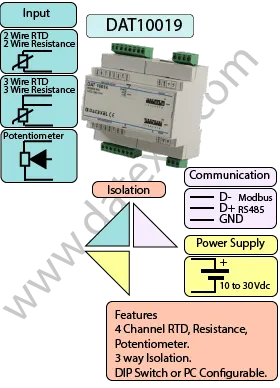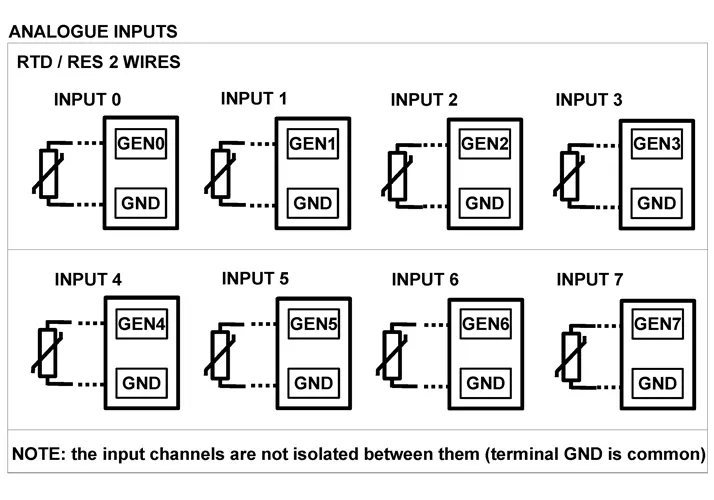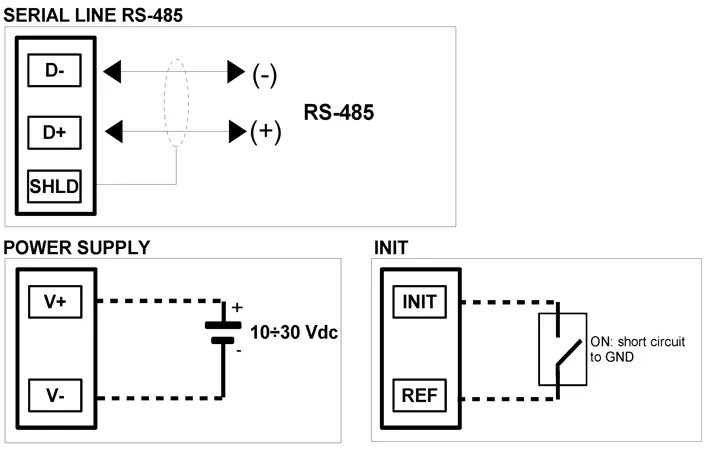8 Channel RTD to Modbus RTU.
DAT10019



The DAT10019 Modbus RTU Converter is an 8-channel input module designed to acquire RTD and resistance signals and transmit them over a Modbus RTU or Modbus ASCII network. It operates as a slave device, making sensor data directly available to PLCs, SCADA systems, and other Modbus masters.
Configuration is simple using DIP switches, which allow the user to set the Modbus address, baud rate, parity, and communication mode (RTU or ASCII). The DAT10019 supports 2-wire RTD sensors only, due to terminal space limitations.
The device provides 1500 Vac galvanic isolation between inputs, outputs, and power supply, ensuring safe operation and noise immunity in industrial environments. It operates from a 10–30 VDC power supply.
| INPUT | OUTPUT | POWER SUPPLY |
|---|---|---|
| 2 Wire RTD, Resistance. | RS485 | Power Supply Voltage 10-30Vdc |
| Reverse polarity protection 60Vdc | ||
| CURRENT CONSUMPTION | CONFIGURATION | ISOLATION |
| Between 35 and 45 mA | PC Programmable | Between Input/Comms/Power Supply 1500Vac. |
| DIP Switch Programmable | ||
| EMC | HOUSING | TEMPERATURE |
| For Industrial environments | Material self-extinguishing | Operating Temperature 14°F +140°F -10°C +60°C |
| Immunity EN 61000-6-2 | Dimensions W x H x T 4.1/4" x 4 1/2" x 2 1/4" | Storage Temperature -40°F +185°F-40°C +85°C |
| Emission EN 6100-6-4 | 106 x 112x x 57 mm | Humidity (non condensing) 0-90% |
| Weight 7 oz 200 g |
| Input: | |
| RTD | 8 Channels Pt100, Pt1000, Ni100, Ni1000 |
| Resistance | 0-500 Ohm, 0-2000 Ohm. |
| Communication: | |
| RS485: | Modbus RTU, Modbus ASCII. |
| Power Supply: | 10 - 30 Vdc. Reverse polarity protection 60 Vdc. |
| Current Consumption: | 30 mA to 45 mA. |
| Temperature rating: | Operative Temperature 14°F +140°F, - 10°C +60°C Storage Temperature - 40°F +185°F, - 40°C +85°C. |
| Humidity: | (not condensing) 0-90%. |
| Housing: | Material self-extinguishing. |
| Dimensions: | W x L x H 4 1/4X 4 1/2 X 2 1/4 inch, 106 x 112 x 57mm. |
| Weight: | 7 oz 200 g. |
| EMC. | For industrial environments. |
| Immunity: | EN 61000-6-2. |
| Emission: | EN 61000-6-4. |
| Isolation: | Between Modbus Master, Input, Power supply 1500Vac, 50Hz, 1 Minute. |
| Configuration: | PC Configurable, DIP Switch. |
| 2 Wire RTD and Resistance Input 0 | Sensor on GND and GEN0 and Compensation on GEN0 |
| 2 Wire RTD and Resistance Input 1 | Sensor on GND and GEN1 and Compensation on GEN1 |
| 2 Wire RTD and Resistance Input 2 | Sensor on GND and GEN2 and Compensation on GEN2 |
| 2 Wire RTD and Resistance Input 3 | Sensor on GND and GEN3 and Compensation on GEN3 |
| 2 Wire RTD and Resistance Input 4 | Sensor on GND and GEN4 and Compensation on GEN3 |
| 2 Wire RTD and Resistance Input 5 | Sensor on GND and GEN5 and Compensation on GEN3 |
| 2 Wire RTD and Resistance Input 6 | Sensor on GND and GEN6 and Compensation on GEN3 |
| 2 Wire RTD and Resistance Input 7 | Sensor on GND and GEN7 and Compensation on GEN3 |

| Power Supply (18-30Vdc). | Positive V+ Negative V-. |
| RS 485 Slave | Positive (D+)B Negative (D-) A GND C |
| Init | Pin Init Ref |
